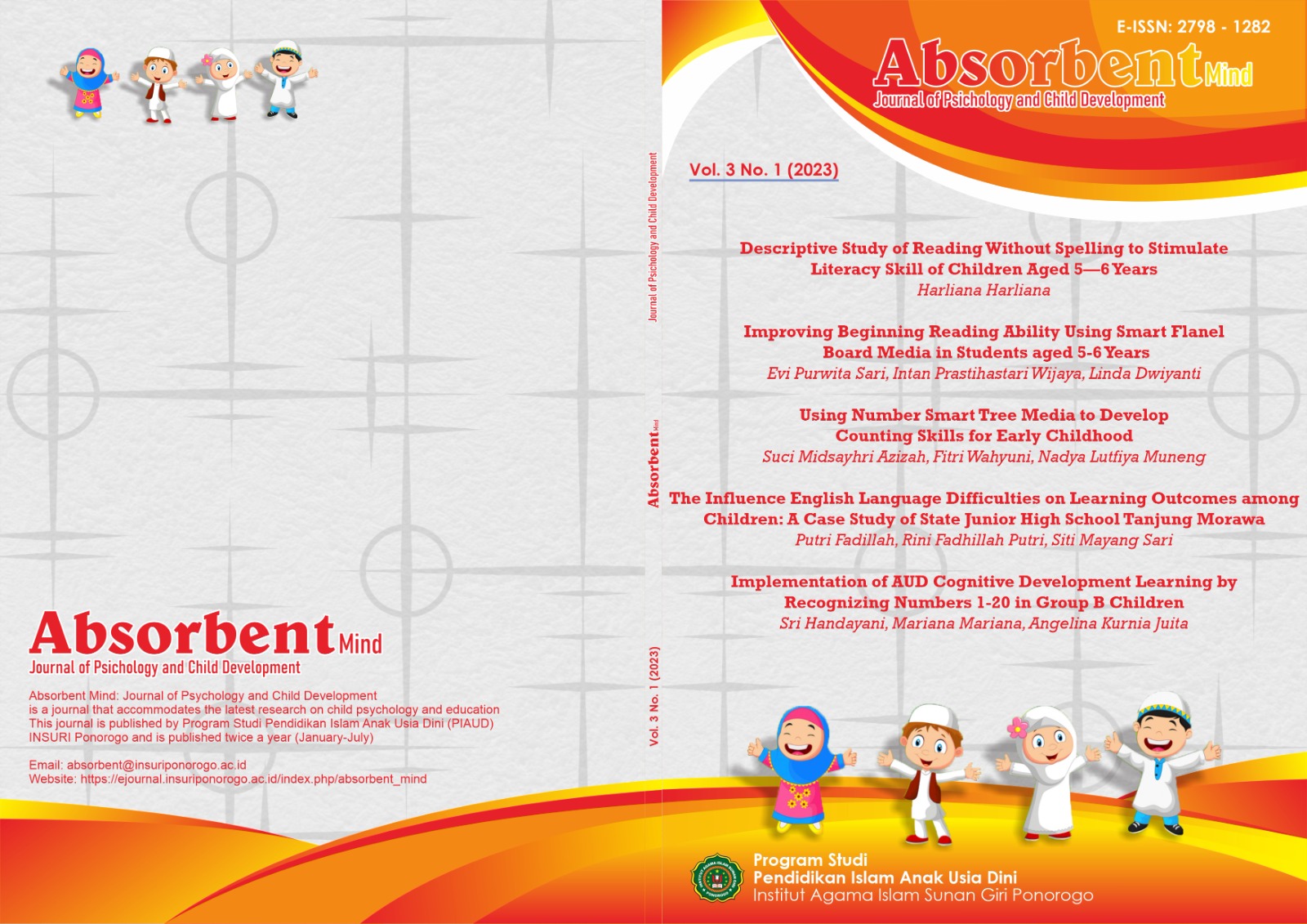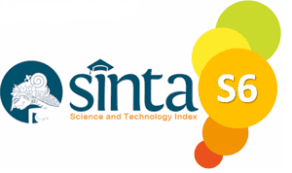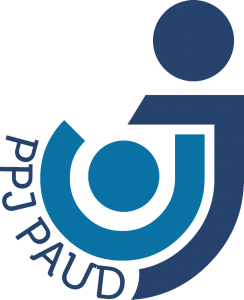Educator Strategies in Instilling Early Childhood Religious Character
DOI:
https://doi.org/10.37680/absorbent_mind.v3i1.2203Keywords:
character education, ecce, educator strategy, religious characterAbstract
This study analyzed educators' strategies for instilling early childhood religious character. This research uses a descriptive qualitative method and data collection procedures through interview techniques, observation, and documentation. The collected data related to students' numeracy skills and the use of innovative tree media were analyzed using data reduction, data presentation, and conclusions. The result of this study is that religious character is an integration of creed, sharia, and morals. PAUD Kartika Buana Pagotan Geger Madiun instills religious feelings in students, which is associated with the creation of PAUD religious culture both related to aspects of creed, sharia, and morals as well as the encouragement of leaders to go through the order of spiritual values that are entrenched in PAUD. The creed aspect is introduced through songs, games, and fairy tales. The Sharia aspect invites students to practice worship, and the moral element is instilled through school rules and student promises. The commitment to maintaining religious culture in PAUD Kartika Buana is always considered, even though the facilities for places of worship have yet to be available.
References
Dewi, R. M., & Mailasari, D. U. (2020). Pengembangan Keterampilan Kolaborasi pada Anak Usia Dini melalui Permainan Tradisional. ThufuLA: Jurnal Inovasi Pendidikan Guru Raudhatul Athfal, 8(2), 220–235.
Fajriyah, L. (2018). Pengembangan Literasi Emergen Pada Anak Usia Dini. Proceedings of The ICECRS, 1(3), 165–172. https://doi.org/10.21070/picecrs.v1i3.1394
Handayani, N. N. L. (2020). Pengaruh Model Pembelajaran Kooperatif Berbantuan Media Gambar Berseri Terhadap Kemampuan Bahasa Dan Kemampuan Dasar Kognitif Anak Kelompok B Tk Negeri Pembina Rendang. Widya Kumara: Jurnal Pendidikan Anak Usia Dini, 1(1), 47–58.
Haryani, S., & Sari, V. M. (2021). Efektifitas Penggunaan Video Pembelajaran dalam Meningkatkan Kognitif Anak Usia 4-5 Tahun di Masa Pembelajaran Jarak Jauh. Jurnal Pendidikan Tambusai, 5(2), 4365–4572.
Hidayati, L., & Yulsyofriend, Y. (2022). Perkembangan Motorik Halus Anak Pada Sentra Seni Dan Kreativitas Di Taman Kanak Kanak Islam Raudhatul Jannah Kota Payakumbuh. Jurnal Family Education, 2(2), 207–219.
Hidayati, R., & Lestari, I. (2021). Permainan Tradisional Jawa Tengah dalam Meningkatkan Kemampuan Motorik Anak Usia Dini. Prosiding Seminar Nasional Bimbingan Dan Konseling Universitas Negeri Malang, 14–24.
Indrawati, R. (2022). Penerapan Metode Pemberian Tugas terhadap Kemampuan Mengenal Bilangan pada Anak Usia Dini. PAUD Lectura: Jurnal Pendidikan Anak Usia Dini, 5(02), 45–52.
Istiyani, D. (2013). MODEL PEMBELAJARAN MEMBACA MENULIS MENGHITUNG. Jurnal Penelitian, 10(1), 1–18.
Lestari, L. D. (2020). Pentingnya mendidik problem solving pada anak melalui bermain. Jurnal Pendidikan Anak, 9(2), 100–108.
Meutia, C. (2021). Peningkatan Hasil Belajar dan Kemampuan Berpikir Kritis Siswa dalam Materi Perhitungan Kimia Melalui Model Pembelajaran Problem Based Learning. Jurnal Kinerja Kependidikan (JKK), 3(1), 39–60.
Miles, M., & Huberman, M. (1992). Qualitative Data Analysis (Diterjemahkan oleh Rohidi (ed.); Cetakan pe). Universitas Indonesia (UI-Press).
Mufid, A., Fatimah, S., Aeeni, N., & Asfahani, A. (2022). Meningkatkan Perkembangan Kecerdasan Naturalistik melalui Metode Outbound (Studi RA Muslimat NU XVII Keser). Absorbent Mind, 2(02), 1–9.
Muhammad Fadillah. (2016). DESAIN PEMBELAJARAN PAUD.pdf. umpo.
Prashanti, N. A. S. (2023). Pengaruh Media Papan Pipa Hitung Terhadap Pemahaman Konsep Lambang Bilangan Pada Anak Usia 4-5 Tahun di TK Darussalam 02 Kartasura.
Rahmaningrum, A., & Fauziah, P. (2020). Peran Guru pada Pengasuhan Anak dari Keluarga Tenaga Kerja Indonesia. Jurnal Obsesi: Jurnal Pendidikan Anak Usia Dini, 5(2), 1282–1292.
Safitri, D., Lestariningrum, A., & Nusantara, U. (2021). Penerapan Media Loose Part untuk Kreativitas Anak Usia 5-6 Tahun. Kiddo: Jurnal Pendidikan Islam Anak Usia Dini, 2(1), 40–52.
Sari, D. R., & Rasyidah, A. Z. (2019). Peran Orang Tua Pada Kemandirian Anak Usia Dini. Early Childhood: Jurnal Pendidikan, 3(1), 45–57.
Sari, T., Yasin, A. F., & Walid, M. (2022). Urgensi Pendidikan Keluarga Dsala Pengembangan Budaya Gemar Membaca Siswa. Khazanah Intelektual, 6(1), 1335–1354.
Setiyaningsih, G., & Syamsudin, A. (2019). Pengembangan media big book untuk meningkatkan kemampuan literasi anak usia 5-6 tahun. Scholaria: Jurnal Pendidikan Dan Kebudayaan, 9(1), 19–28.
Sugiyono. (2019). Metode Penelitian Pendidikan: Kuantitatif, Kualitatif, Kombinasi, R&D dan Penelitian Pendidikan. Alfabeta.
Tahmidaten, L., & Krismanto, W. (2020). Permasalahan budaya membaca di Indonesia (Studi pustaka tentang problematika & solusinya). Scholaria: Jurnal Pendidikan Dan Kebudayaan, 10(1), 22–33.
Talango, S. R. (2020). Konsep perkembangan anak usia dini. Early Childhood Islamic Education Journal, 1(1), 93–107.
Travelancya, T., & Asfahani, A. (2022). Model Pendampingan Penyelenggaraan Kelompok Bermain Holistik & Integratif. Absorbent Mind: Journal of Psychology and Child Development, 2(01), 29–35.
Wahyuni, F., & Asfahani, A. (2021). Menjadi Orang Tua Kreatif bagi Anak Usia Dini di Masa New Normal. Absorbent Mind: Journal of Psychology and Child Development, 1(1), 1–11.
Wijayanti, L. M. (2021). Penguasaan Fonologi dalam Pemerolehan Bahasa (Studi Kasus pada Anak Usia 1.5 Tahun). Absorbent Mind: Journal of Psychology and Child Development, 1(1), 12–24.
Downloads
Published
How to Cite
Issue
Section
License
Absorbent_mind; Journal of Psychology and Child Development allow the author(s) to hold the copyright without restrictions and allow the author(s) to retain publishing rights without restrictions, also the owner of the commercial rights to the article is the author.
License:
- Attribution: You must provide an appropriate name, include a link to the license, and certify that changes have been made. You can do this in an appropriate manner, but do not imply that the licensor supports you or your use.
- Share Alike: If you compose or make derivatives of these materials, you must distribute your contributions under the same license as the original materials.
- No additional restrictions: You may not use legal provisions or technological means of control that legally restrict others from doing the things this license allows.
You are free to:
- Share, copy, and redistribute this material in any form or format.
- Adapt, modify, and create derivatives of this material for any purpose, including commercial purposes.
- The licensor cannot revoke the above terms as long as you comply with the terms of this license.
Creative Commons Attribution-ShareAlike 4.0 International License (CC BY-SA 4.0).







